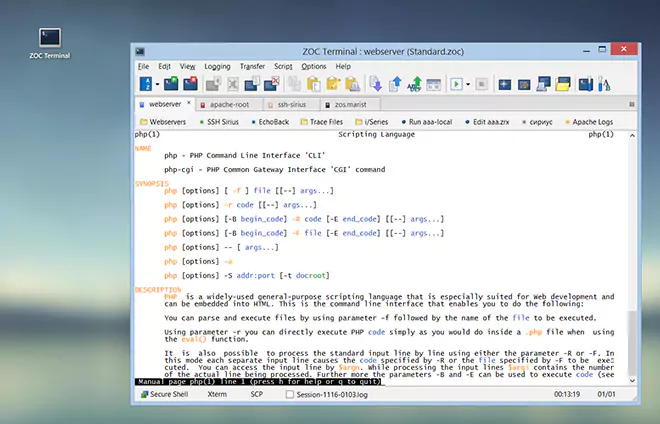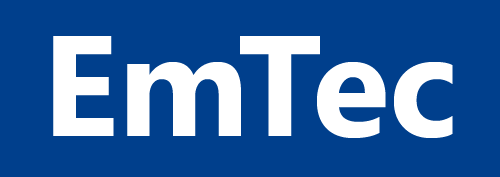 ZOC Terminal is a professional
SSH Client
and
Terminal Emulator
for Windows and macOS.
ZOC Terminal is a professional
SSH Client
and
Terminal Emulator
for Windows and macOS.
APPENDIX → Common Problems and Questions (Trouble Shooting Guide)
Please also read Quick Start Guides for step by step instructions on how to make connections with Telnet, SSH, ISDN etc. And see the How-To Guide.
If you do not find a solution to a problem below, please visit our web site and ask your question via the support request form.
| ZOC tries to access the com port or complains about RTS/CTS when starting | |
This happens when Serial/Modem is set as your default connection type in the session profile.
Please go to Options→Session Profile→Connection Type, then change the
connection type to Telnet, SSH or your preferred method of communication and
save the session profile.
| |
| Telnet/SSH connections to IP addresses only start after a delay | |
ZOC tries to find a matching host name for IP addresses. If you
do not have name server entries for your connections, this may take a few seconds.
To disable the feature, go to Options→Session Profile→Connection Type→Telnet→Global Options
and enable No reverse DNS lookup.
| |
| The transparency option slows down the computer | |
In order to make use of the transparency, you need an up-to-date video board.
Otherwise the system's processor will have to perform the necessary graphical
computations for the transparency effect. If you have an older video board,
please disable the option in Options→Session Profile→Window
and/or Options→Session Profile→Window.
| |
| The selected emulation displays messed up screens | |
Please make sure that the chosen emulation is suitable for the remote host. Via Telnet and SSH the ZOC emulation is automatically communicated to the remote host, so just try to select a different one. Xterm, VT220 or VT102 will work well on many systems, although some systems require quite specific and sometimes arcane choices.
If you are using another terminal emulator that works well on your system,
check its options and see which emulation is used there.
| |
| On Linux systems, Yast/MC etc. show strange characters | |
Please activate the UTF8/Unicode support in the Emulation options
for the Linux emulation (try Xterm/Linux/VT220), or choose the UTF8/Unicode
character set in Session Profile, Layout.
| |
| My emulation basically works, but it shows funny characters instead of line-graphics/boxes | |
Go to Session Profile, Layout and either try the
UTF8/Unicode or the IBM/DOS character set.
| |
| Some F-Keys do not work with my remote system | |
Please make sure that you are using an emulation which supports the full range of F-Keys (e.g. Xterm, VT220, Sun CDE, Ansi SCO or Linux).
Other emulations only support a limited number of f-keys, in that case you
will have to map the correct values (if you know what your host expects)
for the f-keys yourself in the Options→Keyboard Profiles dialog.
| |
| The cursor keys do not work in some VT102/VT220 applications | |
You should use the gray cursor keys, not the numeric keypad. The keypad
is used for other purposes by some remote applications.
| |
| Keyboard redefinition does not work | |
Please note that the keyboard redefinition takes the Num-Lock state into
account. Check your Options→Keyboard Profiles and see if
your keys are mapped depending on the Num-Lock and Scroll-Lock states.
| |
| I cannot connect using Windows-Modems (TAPI) | |
ZOC does not use Window's Local Settings, which means that you have to
type the phone number exactly as you want it to be dialed (including
digits to get an outside line or to dial long distance).
| |
| ZOC cannot open the COM port while other programs can | |
Please make sure that the COM port is available by typing MODE COMx (where x is the number of the port) at a command prompt. If this does not result in an error message, make sure that you typed the com port's name correctly in ZOC. Especially do not use space characters between COM and the number. With higher port numbers (above COM10), some systems require the format \\.\COMxx
The error could also appear if the port is currently used by another program.
| |
| I keep getting a "No CTS from modem" message | |
To prevent ZOC and the modem to overrun each others buffers at times, both should be configured to support the so called RTS/CTS handshake. This is especially necessary with transfer speeds of 9600 bps and more. If you have activated RTS/CTS handshake, ZOC insists on getting the according signal from the modem, because without this signal the communication will be blocked. Hence ZOC issues a warning if the CTS signal from the modem cannot be detected. If you get this warning, please check that your modem is configured to supply the CTS command (e.g. by using the modem's factory settings), that you are using a 7-wire cable (and adapter) between the modem and the PC and that you are using the correct COM-port in Options→Session Profile→Connection Type and/or in Host Directory→Edit.
If the modem or attached device does not support RTS/CTS, turn off RTS/CTS
handshake by clicking the Configure button for Serial/Modem or Serial/Direct.
| |
| Zmodem file transfers via telnet fail | |
Please try different Telnet-options in Options→Session Profile→Connection Type,
or Host Directory→Edit→Connection Type→Configure
(especially with the CR/NUL options) or run rz -e on the remote computer.
| |
| Zmodem uploads to the Linux rz command do not start at all or fail | |
Try to use the -e, -eb or -v option on Unix's side: rz -e, rz -eb or rz -v If your connection is routed through a Xyplex concentrator, there currently
is no known method to make Zmodem uploads at all. You will have to use another
protocol -- best choice in this case is probably CKERMIT used from a transfer
shell from ZOC (please search the help file for CKERMIT to get details).
| |
| Downloads generally work fine, but modem uploads of large files fail | |
Probably you are using a high-speed modem but have RTS/CTS disabled. For
high-speed transmission both, the modem and ZOC, need to be configured
to use RTS/CTS handshaking.
| |
| After downloads the time setting of files is off by a few hours | |
Please check the discussion of the TZ environment variable in the
starter section of this file or set the 'Ignore time stamp' option
in Options→Session Profile→Transfer.
| |
| Whenever I leave the program I get a Carrier Detect warning | |
Maybe your modem is configured to have the CD signal always on. Set it
to match the CD state (maybe AT&C1) or set the CD signal to 'invalid'
in the serial options.
| |
| Sometimes ZOC hangs after starting or when sending to the COM port | |
Try to disable DSR handshake in the options for Serial/Modem.
| |
| My modem works properly with other terminal software but not with ZOC | |
Try using the same modem initialization as in the other terminal package.
Or store that modem configuration into the non-volatile memory of the
modem (mostly done with AT&W) and use ATZ as the initialization string
for ZOC (AT commands are configured from the Serial/Modem device settings).
| |
| ZOC does not show ISDN as a Connection Type under Windows | |
You need CAPI V2.0 drivers from your board manufacturer, which come with
nearly all of the better ISDN cards.
| |
| ISDN can be selected, but connections fail | |
You are probably using a CAPI2032.DLL which does not work with your current drivers, e.g. CAPI2032.DLL from Windows, together with drivers from your board. Also, please set the communication parameters to STANDARD (there is a Standard button in Options→Session Profile→Connection Type→ISDN) and save the options.
Also make sure, that this kind of setting is made in all your ISDN phone
book entries. If you still experience problems, please try to reinstall your ISDN
drivers and make sure that you are using the latest driver kit from your
manufacturer.
| |
| No characters appear after making a modem connection | |
You use a secured transmission and the modem waits to get an OK signal
from the computer which does not come. Turn on RTS/CTS in the options for the
serial connection.
| |
| Sizing the ZOC window only works in large steps | |
By default ZOC changes the font size when you size the window. Since the
font is not available in every necessary size ZOC will use a best-fit
method and size the window accordingly. If you do not like this, you can
change the sizing behavior in the
Options→Session Profile→Window options.
| |
| I would like to use more fonts for ZOC | |
ZOC checks all available fonts in the system to find the ones that could
be used for the terminal window. For use in ZOC all characters in the
font must have the same width and must support the selected code page. | |
| I miss a full screen mode | |
There is no character based full screen mode available. ZOC is a graphical
program and uses the benefits of the graphical user interface (like offering
icons). However, you can maximize the ZOC window using the maximize button in
the title bar. This way ZOC will cover the whole screen (you should select
a large font if you do this).
| |
| I disabled the menu, how can I get it back? | |
You can right-click into the terminal area, this will also bring up the menu.
If you mapped another function on right-click, you will need to manually edit
the session profile (e.g. My Documents > ZOC8 Files > Options > Standard.zoc)
using a text editor.
| |
| Scrolling is slow | |
Scrolling in an window is generally slower than in full screen mode.
There is a scroll speed option in Options→Session Profile→Terminal.
| |
| Is there a host mode? | |
Yes. It is implemented as a REXX program. To start it select
Script, Start Script and select MINIHOST.ZRX. The program will prompt you
for two passwords (for guest and supervisor mode) and will then wait for
incoming calls.
| |
| What does ZOC mean? | |
The Hitchhikers Guide to the Galaxy might describe ZOC as followed: zoc (v), to zoc means communicating with other people through the means of extremely sophisticated hard- and software (sophisticated at least from the viewpoint of the ape-descended inhabitants of an extremely unimportant blue planet in an even lesser important part of the galaxy who think that personal computers are a pretty neat pieces of hardware). | |
← Back to APPENDIX
